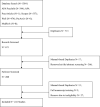Family Related Variables' Influences on Adolescents' Health Based on Health Behaviour in School-Aged Children Database, an AI-Assisted Scoping Review, and Narrative Synthesis
- PMID: 36033089
- PMCID: PMC9400839
- DOI: 10.3389/fpsyg.2022.871795
Family Related Variables' Influences on Adolescents' Health Based on Health Behaviour in School-Aged Children Database, an AI-Assisted Scoping Review, and Narrative Synthesis
Abstract
Objects: Health Behaviours in School-aged Children (HBSC) is an international survey programme aiming to investigate adolescents' health behaviours, subjective perception of health status, wellbeing, and the related contextual information. Our scoping review aimed to synthesise the evidence from HBSC about the relationship between family environmental contributors and adolescents' health-related outcomes.
Methods: We searched previous studies from six electronic databases. Two researchers identified the qualified publications independently by abstract and full-text screening with the assistance of an NLP-based AI instrument, ASReview. Publications were included if they were based on HBSC data and investigated the effects of family environment on adolescents' health outcomes. Researches addressed family-related factors as mediators or moderators were also included.
Results: A total of 241 articles were included. Family environmental contributors could be mapped into six categories: (1) Demographic backgrounds (N = 177); (2) General family's psycho-socio functions (N = 44); (3) Parenting behaviours (N = 100); (4) Parental health behaviours (N = 7); (5) Family activities (N = 24); and (6) Siblings (N = 7). Except for 75 papers that assessed family variables as moderators (N = 70) and mediators (N = 7), the others suggested family environment was an independent variable. Only five studies employed the data-driven approach.
Conclusion: Our results suggest most research studies focussed on the influences of family demographic backgrounds on adolescents' health. The researches related to parental health behaviours and siblings are most inadequate. Besides, we recommend further research studies to focus on the mediator/moderator roles of the family, for exploring the deep mechanism of the family's impacts. Also, it would be valuable to consider data-driven analysis more in the future, as HBSC has mass variables and data.
Keywords: AI-assisted scoping review; HBSC database; adolescents’ health; family environment; parenting behaviour.
Copyright © 2022 Huang, Procházková, Lu, Riad and Macek.
Conflict of interest statement
The authors declare that the research was conducted in the absence of any commercial or financial relationships that could be construed as a potential conflict of interest.
Figures
Similar articles
-
Family factors to predict adolescents' emotional health by decision tree model: A comparison between normally developed group and chronic-condition group.Front Public Health. 2023 Mar 16;11:1087547. doi: 10.3389/fpubh.2023.1087547. eCollection 2023. Front Public Health. 2023. PMID: 37006522 Free PMC article.
-
Beyond the black stump: rapid reviews of health research issues affecting regional, rural and remote Australia.Med J Aust. 2020 Dec;213 Suppl 11:S3-S32.e1. doi: 10.5694/mja2.50881. Med J Aust. 2020. PMID: 33314144
-
Adolescents' sleep quality in relation to peer, family and school factors: findings from the 2017/2018 HBSC study in Flanders.Qual Life Res. 2021 Jan;30(1):55-65. doi: 10.1007/s11136-020-02614-2. Epub 2020 Aug 31. Qual Life Res. 2021. PMID: 32865698
-
Theories of Change and Mediators of Psychotherapy Effectiveness in Adolescents With Externalising Behaviours: A Systematic Review.Front Psychiatry. 2022 Jan 14;12:730921. doi: 10.3389/fpsyt.2021.730921. eCollection 2021. Front Psychiatry. 2022. PMID: 35095586 Free PMC article.
-
Parenting interventions to support parent/child attachment and psychosocial adjustment in foster and adoptive parents and children: A systematic review.Campbell Syst Rev. 2022 Jan 5;18(1):e1209. doi: 10.1002/cl2.1209. eCollection 2022 Mar. Campbell Syst Rev. 2022. PMID: 36913207 Free PMC article. Review.
Cited by
-
Parenting Practices and Psychosomatic Complaints Among Swedish Adolescents.Int J Public Health. 2023 Dec 21;68:1606580. doi: 10.3389/ijph.2023.1606580. eCollection 2023. Int J Public Health. 2023. PMID: 38179321 Free PMC article.
-
"It Doesn't Cure, but It Protects": COVID-19 Vaccines through the Eyes of Children and Their Parents.Vaccines (Basel). 2023 Jul 31;11(8):1305. doi: 10.3390/vaccines11081305. Vaccines (Basel). 2023. PMID: 37631873 Free PMC article.
-
Normal weight obesity in adolescents: patterns and associated factors.Front Nutr. 2025 Jul 21;12:1637885. doi: 10.3389/fnut.2025.1637885. eCollection 2025. Front Nutr. 2025. PMID: 40761357 Free PMC article.
-
Anxiety in Children: The Contribution of Parental Characteristics.Children (Basel). 2025 Apr 25;12(5):553. doi: 10.3390/children12050553. Children (Basel). 2025. PMID: 40426732 Free PMC article.
-
Differential Associations of Sports Participation With Self-Rated Health and Depressive Symptoms Among Japanese Adolescents.Cureus. 2023 Aug 19;15(8):e43776. doi: 10.7759/cureus.43776. eCollection 2023 Aug. Cureus. 2023. PMID: 37731422 Free PMC article.
References
-
- Aarø L. E., Wold B., Kannas L., Rimpelä M. (1986). Health behaviour in schoolchildren A WHO cross-national survey: a presentation of philosophy, methods and selected results of the first survey. Health Promot. Int. 1 17–33.
-
- Amato P. R. (2014). The consequences of divorce for adults and children: an update. Društvena Istraživanja 23 5–24.
-
- Aromataris E., Munn Z. (2020). JBI Manual for Evidence Synthesis. Adelaide: JBI. 10.46658/JBIMES-20-01 - DOI
-
- Bakalar P., Kopcakova J., Geckova A. M. (2019). Association between potential parental and peers’ correlates and physical activity recommendations compliance among 13-16 years old adolescents. Acta Gymnica 49 16–24. 10.5507/ag.2018.027 - DOI
Publication types
LinkOut - more resources
Full Text Sources


